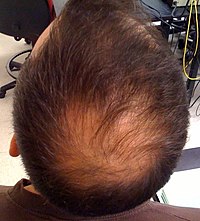
Photo from wikipedia
PROBLEM IDENTIFICATION There is a lack of guideline recommendations about the use of scalp cooling for preventing chemotherapy-induced alopecia (CIA). This overview was conducted to summarize effectiveness, safety, and tolerance… Click to show full abstract
PROBLEM IDENTIFICATION There is a lack of guideline recommendations about the use of scalp cooling for preventing chemotherapy-induced alopecia (CIA). This overview was conducted to summarize effectiveness, safety, and tolerance of scalp cooling for CIA based on systematic reviews. LITERATURE SEARCH PubMed®, Embase®, Cochrane Library, and CNKI were searched from inception to May 15, 2021. DATA EVALUATION AMSTAR 2 was used to assess the methodologic quality. Qualitative and quantitative synthesis methods were used to identify the effectiveness, safety, and tolerance of scalp cooling. SYNTHESIS 14 systematic reviews were identified, and the quality assessment was poor. Scalp cooling has been considered to be effective for preventing chemotherapy-induced alopecia and has been confirmed in patients with breast cancer and other solid tumors. Most adverse effects were mild and moderate, and scalp cooling did not increase the risk of scalp metastases. IMPLICATIONS FOR RESEARCH This overview could guide nurses to provide access to scalp cooling to reduce the risk of severe or total chemotherapy-induced alopecia for patients undergoing chemotherapy. The large-scale application of scalp cooling may be promoted by establishing reimbursement mechanisms and increasing available devices in the future.
Journal Title: Oncology nursing forum
Year Published: 2022
Link to full text (if available)
Share on Social Media: Sign Up to like & get
recommendations!